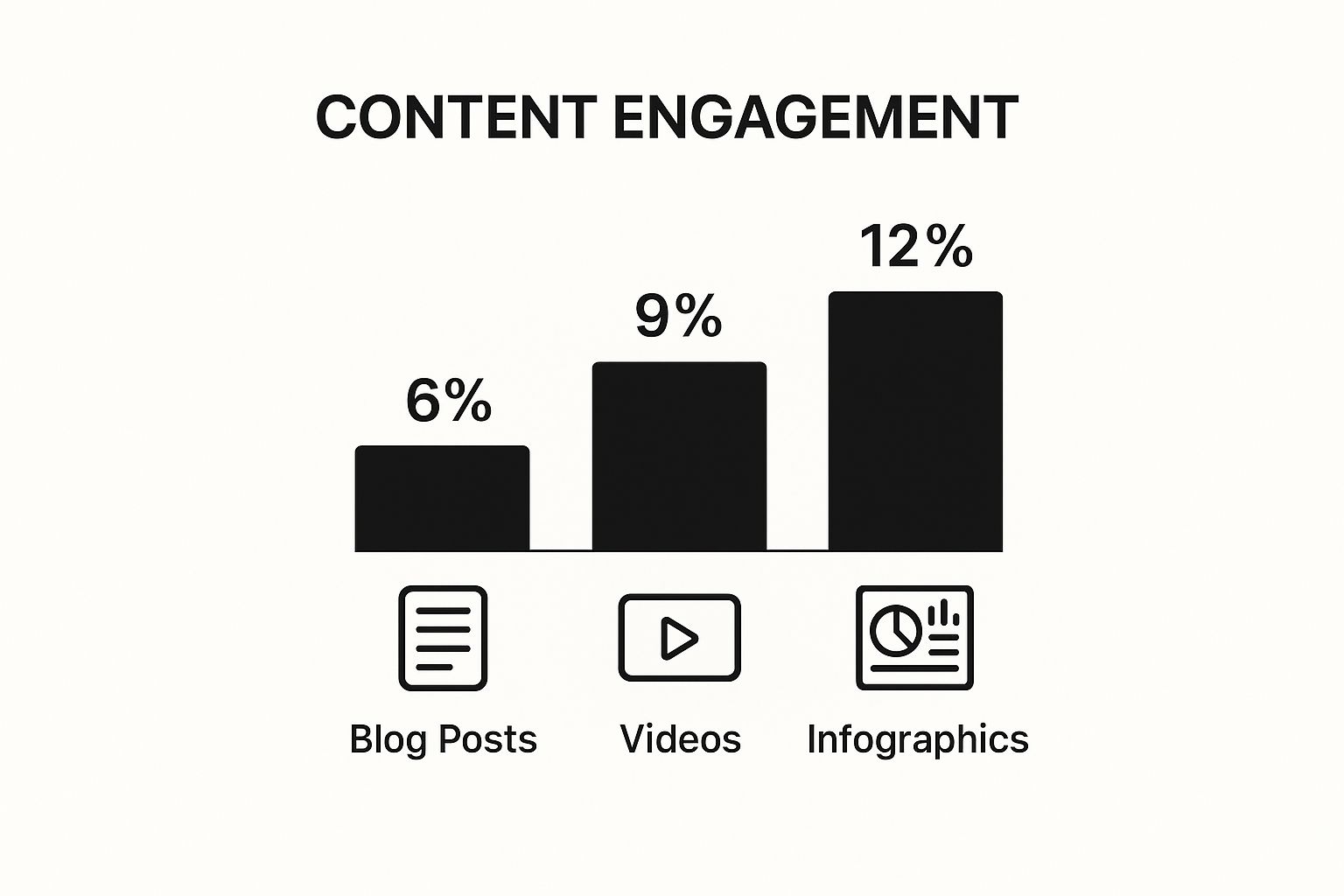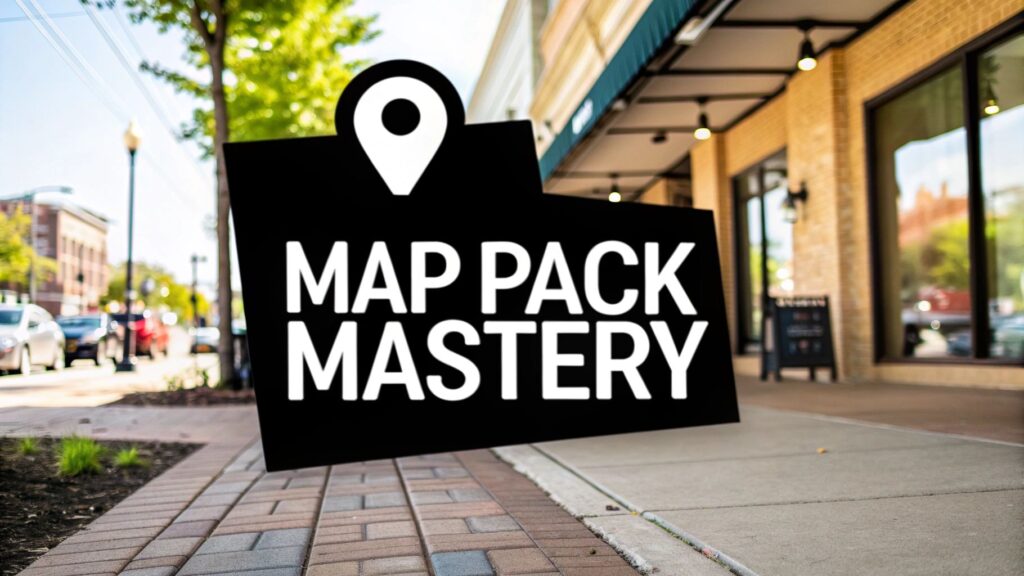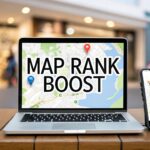You're a great massage therapist, but how do new clients find you? Let's talk about SEO for massage therapists. Think of it as your best employee, working 24/7 to connect you with people in your area searching for relaxation and pain relief.
SEO for massage therapists is the process of making your website more visible on search engines like Google. This guide will show you how to do it.
Why SEO Is Your Best Client Magnet
You have the skills to help people feel better. But if they can't find you online, your appointment book will stay empty. Search Engine Optimization (SEO) connects your expertise with local clients who need it.
This isn't about becoming a tech expert. It's about showing up when someone nearby searches "deep tissue massage near me" or "best prenatal massage in [Your City]."
A good online presence is essential. When someone is in pain or stressed, their first move is a Google search. They want a solution now. SEO puts your practice front and center at that moment.
In Short: Good SEO makes your practice the obvious choice for local clients searching online for the services you offer.
The Growing Demand for Massage Therapy
The wellness industry is growing fast. The global massage therapy service market is expected to reach $126.8 billion by 2035. More people are prioritizing their health and looking for ways to manage stress.
This means more potential clients, but also more competition. Good SEO makes you stand out. You can read the full research on the massage therapy market to see the opportunity.
For example, think about what a client sees when they search "massage therapy near me."

That map with the top three businesses is the "Local Pack." Getting your practice listed there is the goal of local SEO. It grabs the attention of people ready to book.
Here's a quick list of the most important local SEO tasks.
Top Local SEO Priorities for Your Massage Practice
| SEO Component | Why It Matters | Quick Action Step |
|---|---|---|
| Google Business Profile | This is your digital storefront. It's often the first impression a client has and is crucial for appearing on Google Maps. | Claim and fully complete your Google Business Profile, adding services, photos, and hours. |
| Local Keyword Research | You need to know the exact phrases people use to find services like yours in your area. | Use Google's search bar for autocomplete suggestions for "massage therapy [Your City]" or "sports massage near me." |
| On-Page SEO | This tells Google what your website is about, ensuring you show up for relevant searches. | Add your primary service and city to your homepage title (e.g., "Deep Tissue & Swedish Massage in Austin, TX"). |
| Local Citations & Reviews | Consistent business listings (like Yelp) and positive reviews build trust with Google and clients. | Ask happy clients for a review on your Google profile. Ensure your business name and address are identical everywhere. |
Focusing on these areas will build a strong foundation for a steady stream of local clients.
What does good SEO do for a massage therapist?
Good SEO is a mix of strategies that build your online reputation and bring clients to your door.
- You Get Seen: It helps you appear in the Google Maps "Local Pack."
- You Build Trust: High rankings and good reviews show clients you're a professional.
- You Attract Ready-to-Book Clients: SEO connects you with people actively looking for a massage.
- It's a Long-Term Investment: Unlike paid ads, SEO builds on itself over time.
Uncovering Keywords That Bring Local Clients Through Your Door
Keyword research is about understanding the words your potential clients type into Google. Getting this right is the foundation of solid SEO for massage therapists.
Forget generic terms like "massage." We need to think like a local person who is in pain or stressed and ready to book an appointment.
We are looking for "high-intent, local keywords." These phrases lead directly to bookings because they show someone is looking for a specific service in a specific place.

This image from Google Keyword Planner shows how powerful this is. You can see how many people search for a term. A phrase like "deep tissue massage near me" gets thousands of searches each month.
Think Like Your Ideal Client
Put yourself in your client's shoes. What is driving their search? Are they dealing with a back injury, training for a race, or seeking relaxation during pregnancy?
Their situation changes what they type in the search bar.
- Someone with back pain might search for "therapist for lower back pain in [Your City]."
- A runner might look up "sports massage therapist [Your Neighborhood]."
- An expecting mother searches for "certified prenatal massage near me."
These are long-tail keywords. They are longer and more specific. Fewer people search for them, but those who do are highly qualified and ready to book.
Finding Gold with Free Tools
You don't need expensive software to find good keywords. Google offers great free tools. This approach works for any local service, as seen in this guide to SEO for a cleaning business.
Start by typing your main services into the Google search bar and see what it suggests.
Pro Tip: Always use an "Incognito" or "Private" browser window. This prevents your personal search history from affecting the results.
The "People Also Ask" box in search results is another great source. It shows you the questions people have about your services. Each question is a potential blog post topic.
What Are Some Good Keywords for a Massage Therapist?
The best keywords combine what you do and where you do it. Think about what makes your practice special.
Here are some ideas to start with:
- By Service: "Swedish massage," "hot stone therapy," "trigger point therapy"
- By Condition: "massage for sciatica," "headache relief massage," "carpal tunnel massage"
- By Location: "[Your City] deep tissue massage," "[Your Neighborhood] wellness center"
Combine them to create powerful phrases like "sciatica relief massage in downtown Denver."
How Do I Find My SEO Keywords?
Finding your core keywords is a straightforward process. It starts with brainstorming.
- List Your Specialties: Write down every type of massage you offer (deep tissue, sports, prenatal, etc.).
- Add Your Location: Add your city and neighborhood to each service (e.g., "sports massage in South Austin").
- Use Google Keyword Planner: Put those ideas into the free Google Keyword Planner. It will show you search volume and suggest related keywords.
- Spy on the Competition: Search for your most important keywords and see which competitors appear. Look at their website titles and headings to see what keywords they are targeting.
How Do I Target Local Keywords?
Once you have your keywords, you need to place them on your website. This helps clients and Google understand what you do and where you do it.
- Your Homepage Title: This is prime real estate. Make it clear, like "Serenity Massage | Professional Deep Tissue Massage in Portland, OR."
- Dedicated Service Pages: Create a separate page for each service. A page focused on "Prenatal Massage in Portland" will rank better for that search than a general "Services" page.
- Your Contact Page: List your full business name, address, and phone number. Embed a Google Map of your location.
- Blog Content: Write articles that answer local questions. For example, "Finding the Best Sports Massage in the Pearl District."
By weaving these local keywords into your website, you tell Google that your practice is the most relevant answer for searchers in your community.
Your Google Business Profile: The Cornerstone of Your Local SEO
If you focus on one thing for local SEO, make it your Google Business Profile (GBP). This free listing appears in Google Maps and local search results. It's often a potential client's first impression of your practice.
In Short: Your Google Business Profile is your digital front door and can be your top source for new local clients.
It shows your address, hours, photos, and client reviews. When managed well, this tool can be your number one source for new clients, and it's free.
First, you must claim and verify your profile. This gives you control over the information people see.

This dashboard is your command center. From here, you can update services, add photos, and communicate with potential clients.
Building Your Profile From the Ground Up
Accuracy and detail are key. Fill out every field to give Google more information to show your practice to the right people.
Nail the essentials:
- Business Name: Use your real business name. Do not add keywords like "Best Deep Tissue Massage."
- Address: Make sure it's 100% correct.
- Phone Number: Use a local number.
- Website: Link to your homepage or online booking page.
Next, add personality. In your business description, include some of your keywords. Talk about what makes you unique and who you help.
A completely filled-out profile looks more legitimate to Google and will show up more often in local searches.
Choosing Your Categories and Services
This is a powerful setting. Your primary category should be the most accurate description of your business. For most, this will be “Massage Therapist.”
Then, add secondary categories if they apply, such as:
- Wellness Center
- Physical Therapy Clinic
- Sports Massage Therapist
Next, list every service you offer. Use the services section to add custom services with descriptions and prices. If you offer "Hot Stone Massage," "Prenatal Massage," and "Trigger Point Therapy," list them all. This helps you appear in searches for specific treatments.
How Do I Keep My Google Business Profile Optimized?
An optimized profile needs regular attention to stay fresh and keep Google's attention.
- Keep the Photos Coming: Show off your space. Post pictures of your treatment rooms, the front of your building, and a friendly photo of yourself. For inspiration, check out these creative photo ideas.
- Use Google Posts: Use this feature like a mini-blog. Share last-minute openings, new services, or special offers. Post every week or two to show Google you're active.
- Turn on the Booking Button: Make it easy for people to book an appointment directly from your profile. Most scheduling tools can integrate with GBP.
- Use the Q&A Section: Answer questions people ask on your profile. You can also add your own FAQs, like "Do you offer gift certificates?" or "What's your cancellation policy?"
The Unstoppable Power of Client Reviews
Reviews are essential for a local business. They are a major ranking factor for Google.
A steady stream of positive reviews signals to Google that you are a trusted therapist. Ask every happy client for a review. A follow-up email with a direct link to your GBP review page works well.
Also, respond to every single review. A "thank you" for a positive review shows gratitude. A professional response to a negative one shows you are committed to client satisfaction.
Getting Your Website Ready for Bookings
When a potential client clicks on your website, it has one job: to turn that click into an appointment. This is about on-page SEO.
If your Google Business Profile is the sign on your door, your website is the calm, professional space inside.
Let's make sure your site is working for you.
Weave Your Keywords into Your Core Pages
Use your keyword list naturally in the places where they have the biggest impact.
- Page Titles (Meta Titles): This is the headline people see in Google search results. For example: "Relaxing Swedish & Deep Tissue Massage in Austin, TX."
- Headings (H1, H2 tags): Your main page heading (H1) should be clear, like "Therapeutic Massage in Downtown Austin." Use subheadings (H2s, H3s) to break up content and include related terms.
- Service Descriptions: Describe your services using words clients would use. For example, "myofascial release to relieve chronic back pain."
This sends clear signals to Google about what you do and who you serve. This is the foundation of SEO for massage therapists.
Create Dedicated Pages for Each Service You Offer
This is important. Do not lump all your services onto a single page. Each service—Swedish, Deep Tissue, Hot Stone, Prenatal—deserves its own page.
Someone searching for "hot stone massage near me" wants to land on a page all about hot stone massage.
Individual pages also allow you to explain the benefits and what to expect. This helps you target specific keywords and builds trust with potential clients.
Make Sure Your Website is Fast and Mobile-Friendly
More than half of all web traffic comes from mobile devices. If your site is slow or looks bad on a phone, visitors will leave.
Your website must have a responsive design. This means it adjusts to look good on any screen size.
Speed is also a major ranking factor for Google. Use a free tool like Google PageSpeed Insights to check your site's speed.
This report shows how your site performs and what to fix. Aiming for the green "good" range will improve user experience and rankings.
Add Obvious Calls to Action
Guide your visitors. Every page should have a clear call-to-action (CTA). This is usually a button that stands out with simple text like "Book Now" or "Schedule Your Massage."
Place these buttons in your main menu, at the end of every service description, and on your contact page. The easier you make it to book, the more bookings you'll get.
In Short: A well-optimized website creates a smooth, professional experience for your clients. To ensure you've covered everything, use a WordPress website audit checklist.
Building Local Authority and Trust
Your online reputation is like modern word-of-mouth. When other local websites mention your practice, Google sees it as a signal that you are a trusted expert. This part of SEO for massage therapists is about getting your name out there through local citations and backlinks.
Let’s break down what these are.
First Up: What Are Local Citations?
A local citation is any online mention of your business's Name, Address, and Phone number (NAP). You can find them on directory sites like Yelp, Yellow Pages, and health-and-wellness websites.
The most important rule is NAP consistency. Your name, address, and phone number must be exactly the same everywhere they are listed online. No variations. This consistency builds a trustworthy profile that search engines can easily understand.
For many clients, their search starts on a directory they trust, like Yelp.

Being listed with accurate info makes it easy for them to find you. This applies to all local service businesses, as seen in this guide on SEO for barbershops.
How to Get Started with Citation Building
Building citations is straightforward. Focus on the most impactful sites.
- Start with the big names: Get listed on Yelp, Apple Maps, and Bing Places.
- Find industry-specific sites: Look for health and wellness directories.
- Go local: List your business on your local Chamber of Commerce website or city-specific directories.
Keep a spreadsheet to track your listings and ensure your NAP is consistent everywhere.
The Power of a Good Backlink
While citations are mentions, backlinks are clickable links from another website to yours. They are like a vote of confidence. When a respected local blog or business links to your site, it tells Google you are legitimate.
Earn these links naturally.
- Partner up: Connect with a nearby yoga studio or chiropractor. Offer to link to them if they will link to you.
- Reach out to local bloggers: Offer a complimentary session to a local wellness blogger for an honest review or mention.
- Get involved in the community: Sponsor a local 5K or health fair. This often comes with a link from the event's website.
Local Citation vs Backlink
These two have different roles in your SEO strategy. Here's a quick comparison:
| Feature | Local Citations | Backlinks |
|---|---|---|
| What it is | A mention of your Name, Address, Phone (NAP) | A clickable link from another site to yours |
| Primary Goal | Verify your location and contact info | Pass authority and act as a "vote of confidence" |
| Where to find them | Business directories (Yelp, Yellow Pages) | Local blogs, partner websites, news articles |
| SEO Impact | Crucial for local map pack rankings | Boosts overall website authority and rankings |
In Short: Citations confirm who and where you are, while backlinks confirm you're trusted. You need a mix of both.
Creating Helpful Content Your Clients Will Love
Content is how you show your expertise and attract clients. A helpful blog is a powerful tool for your massage therapy SEO. It's about building trust and showing people you're the expert in your area.
You don't need to be a professional writer. Your goal is to answer the questions your clients ask you every day. If you've ever explained the benefits of massage for back pain, you have a great blog post idea.
Turn Client Questions into Blog Topics
The best content comes from your real-world experience. Think about what your last five clients asked you. Each question is a potential blog post that someone in your area is searching for on Google.
This approach ensures your content is helpful and relevant.
- Ease their worries: Write a post like "What to Expect During Your First Deep Tissue Massage."
- Solve their problems: A post about "5 Ways Regular Massage Can Help with Sciatica Pain" targets people looking for a solution.
- Show off your skills: A post like "How Trigger Point Therapy Works for Headache Relief" highlights your expertise.
The most powerful content strategy is simply answering your clients' frequently asked questions on your blog.
How Content Actually Builds Your Business
This type of content does more than just bring people to your website. It's a solid strategy for long-term growth. Employment for massage therapists is projected to grow by 18% over the next decade, so standing out is crucial. You can learn more about massage therapy's future trends to see how important an online presence is.
For a broader look at content planning, this guide on effective content creation for small business success has great insights.
How Do I Come up with Blog Ideas for My Massage Business?
Inspiration is all around you. Keep a notebook and write down questions clients ask during sessions.
You can also use free tools. Go to Google, type a phrase like "benefits of massage for…" and see what autocomplete suggests. The "People Also Ask" box is a goldmine of topics.
When you combine real-world questions with keyword research, you'll create a content plan that brings the right clients to your door.
Frequently Asked Questions About SEO
When you're figuring out SEO for your massage practice, questions come up. Here are some straight answers to common questions.
How long does SEO take to work for a massage therapist?
Think of SEO as a long-term investment. You should start to see positive movement in your local rankings within about 3 to 6 months. This requires consistent work on your Google Business Profile, building local citations, and creating useful content.
The effort you put in today will continue to pay off in the future. It's not like an ad that stops when you stop paying. You are building an asset that will bring in clients for years.
Is this SEO thing going to cost me a fortune?
No, it doesn't have to. Many of the most effective local SEO tactics are 100% free.
Things like optimizing your Google Business Profile, doing keyword research, and asking clients for reviews cost nothing. The main ideas are the same for most local businesses, whether you are a massage therapist or running a nail salon, as shown in this nail salon SEO guide.
In Short: Your biggest investment is your time. You can make a big impact with a DIY approach, especially on a tight budget.
Can't I Just Post on Instagram and Call It a Day?
Social media is great for building a community, but it's not a substitute for SEO. They have different jobs.
People go to social media to be entertained. They go to Google when they have a problem they need to solve right now, like a stiff neck that needs a "deep tissue massage near me."
Here's a simple way to look at it:
- Social Media: Good for connecting with current clients and building brand awareness.
- SEO: Catches new clients who are actively searching for your services and are ready to book.
You need both to work together. They are different tools for different, but equally important, goals.
Is Your Business Ranking in Google Maps?
Turn Google Maps into a Lead Engine w/ Clicks Geek’s AI-powered local SEO. 3,000+ clients served. Our proprietary, fully done-for-you Maps SEO system handles everything—keyword targeting, local optimization, content, reviews, and ranking strategy—automatically.






